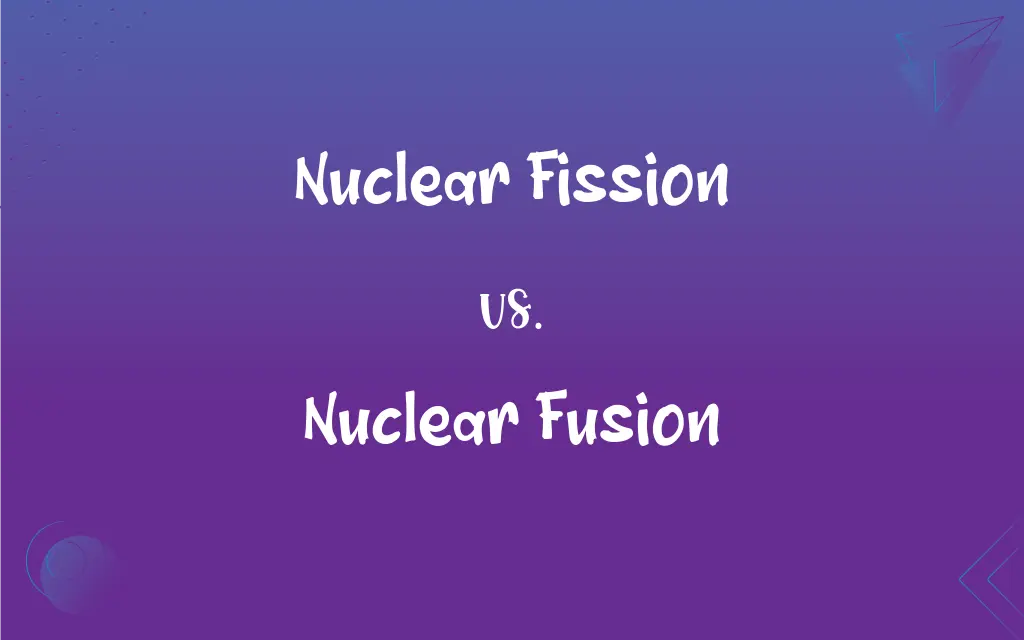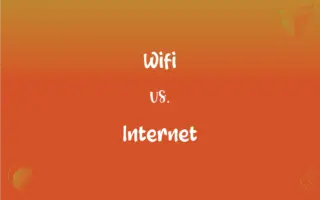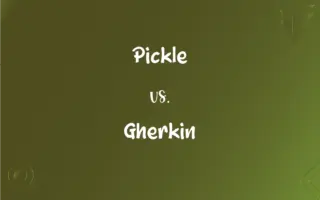Nuclear Fission vs. Nuclear Fusion: What's the Difference?
Edited by Aimie Carlson || By Harlon Moss || Updated on October 4, 2023
Nuclear Fission splits heavy atomic nuclei into lighter ones, releasing energy; Nuclear Fusion combines light nuclei, also releasing energy.

Key Differences
Nuclear Fission is a process where an atomic nucleus is divided into two or more smaller nuclei, accompanied by the release of energy. Nuclear Fusion, on the other hand, is the combination of two light atomic nuclei to form a heavier nucleus, which also releases energy. Both are nuclear reactions, but the mechanisms and results are different.
While Nuclear Fission is primarily used in nuclear power plants and atomic bombs, Nuclear Fusion is the energy source of the sun and other stars. Both processes release vast amounts of energy, but they achieve it through opposite approaches. Fission breaks down, while Fusion joins together.
The fuels used in Nuclear Fission typically include heavy elements like uranium or plutonium. In contrast, Nuclear Fusion predominantly employs light elements like hydrogen isotopes (deuterium and tritium). Fission produces radioactive waste, whereas Fusion's primary byproducts are harmless, like helium.
Nuclear Fission's energy release comes from the binding energy of heavy atomic nuclei getting converted to kinetic energy. Nuclear Fusion's energy release is a result of the conversion of mass into energy, following Einstein's famous equation, E=mc^2.
Lastly, while current nuclear power plants rely on Nuclear Fission, the promise of harnessing Nuclear Fusion for energy has been pursued for decades. Fusion offers potential advantages like abundant fuel sources and reduced radioactive waste.
ADVERTISEMENT
Comparison Chart
Process
Splits heavy atomic nuclei
Combines light atomic nuclei
Common Fuels
Uranium, Plutonium
Hydrogen isotopes (Deuterium, Tritium)
Primary Uses
Nuclear power plants, atomic bombs
Energy source for stars
Byproducts
Radioactive waste
Mainly harmless byproducts, e.g., helium
Energy Origin
Binding energy of heavy nuclei
Conversion of mass to energy
ADVERTISEMENT
Nuclear Fission and Nuclear Fusion Definitions
Nuclear Fission
Nuclear Fission results in radioactive waste.
Managing the byproducts of Nuclear Fission is an environmental challenge.
Nuclear Fusion
Nuclear Fusion requires high temperatures and pressures.
Replicating the conditions for Fusion on Earth is challenging.
Nuclear Fission
Nuclear Fission is initiated by bombarding the nucleus with a neutron.
The neutron's impact caused the atom to undergo Fission.
Nuclear Fusion
Nuclear Fusion combines light atomic nuclei to produce a heavier nucleus.
The sun's energy comes from Nuclear Fusion.
Nuclear Fission
Nuclear Fission is the primary process in modern nuclear reactors.
The power plant uses Nuclear Fission to produce electricity.
Nuclear Fusion
Nuclear Fusion's primary byproduct is often helium.
After Fusion occurs, helium is one of the main products.
Nuclear Fission
Nuclear Fission is the division of an atomic nucleus into smaller parts.
The reactor harnesses energy through Nuclear Fission.
Nuclear Fusion
Nuclear Fusion releases energy by merging atomic nuclei.
Scientists aim to harness the power of Fusion for clean energy.
Nuclear Fission
Nuclear Fission releases energy by splitting heavy nuclei.
When uranium undergoes Fission, a substantial amount of energy is released.
Nuclear Fusion
Nuclear Fusion offers potential for limitless, clean energy.
With Nuclear Fusion, we could have a nearly inexhaustible energy source.
FAQs
Is Nuclear Fission used in power plants?
Yes, many nuclear power plants use Nuclear Fission to produce electricity.
What is Nuclear Fission?
Nuclear Fission is the splitting of a heavy atomic nucleus into smaller nuclei, releasing energy.
How does Nuclear Fusion work?
Nuclear Fusion combines two light atomic nuclei to form a heavier nucleus, releasing energy.
What are the byproducts of Nuclear Fission?
Fission produces several byproducts, including radioactive waste.
Why isn't Fusion used in current power plants?
Achieving and maintaining the conditions for Nuclear Fusion on Earth has been technologically challenging.
Can we run out of Fusion fuel?
Fusion uses abundant fuels, making it unlikely we'll run out anytime soon.
Is Nuclear Fusion the future of energy?
Many scientists believe Fusion has the potential to be a major future energy source.
Are Fission reactors safe?
Modern Fission reactors have safety measures, but risks exist, like meltdowns or radiation release.
What fuels Nuclear Fusion?
Fusion typically uses light elements, like hydrogen isotopes such as deuterium and tritium.
Which process occurs in the sun, Fission or Fusion?
The sun derives its energy from Nuclear Fusion.
Is Nuclear Fusion environmentally friendly?
Fusion has the potential to be cleaner, with fewer radioactive byproducts than Fission.
Which process releases more energy, Fission or Fusion?
Both release vast amounts of energy, but per reaction, Fusion releases more than Fission.
Can Fusion replace all other energy sources?
While Fusion has great potential, a diverse mix of energy sources will likely be needed for various applications.
Are there dangers associated with Nuclear Fission?
Yes, Fission can produce harmful radiation and long-lived radioactive waste.
How hot does it need to be for Fusion to occur?
Fusion requires temperatures of millions of degrees Celsius, similar to the core of stars.
Which is more abundant, Fission fuel or Fusion fuel?
Fusion fuel, like hydrogen, is more abundant than Fission fuels like uranium.
Do we have Fusion reactors on Earth?
There are experimental Fusion reactors, but none are yet used for widespread power production.
Why is Fission associated with atomic bombs?
The energy released in Fission is harnessed in atomic bombs for destructive purposes.
Is the waste from Nuclear Fusion safe?
Fusion's primary byproducts, like helium, are non-radioactive and safe.
Are Fission and Fusion the only nuclear reactions?
No, but they are the most well-known due to their potential for energy production.
About Author
Written by
Harlon MossHarlon is a seasoned quality moderator and accomplished content writer for Difference Wiki. An alumnus of the prestigious University of California, he earned his degree in Computer Science. Leveraging his academic background, Harlon brings a meticulous and informed perspective to his work, ensuring content accuracy and excellence.
Edited by
Aimie CarlsonAimie Carlson, holding a master's degree in English literature, is a fervent English language enthusiast. She lends her writing talents to Difference Wiki, a prominent website that specializes in comparisons, offering readers insightful analyses that both captivate and inform.































































